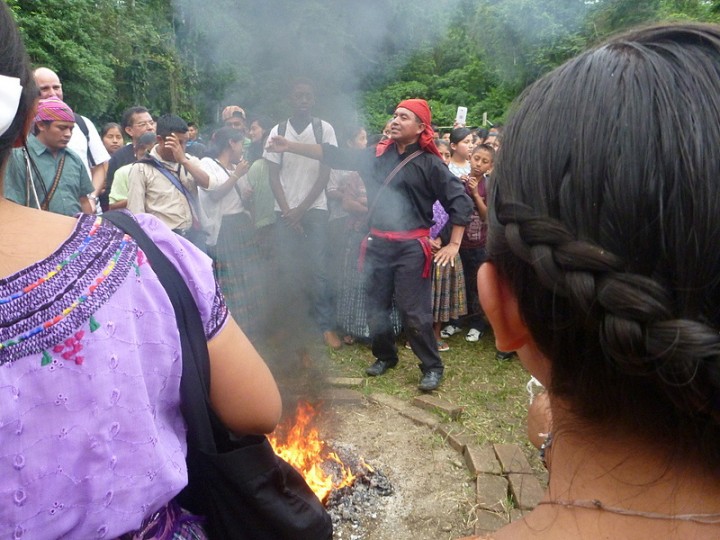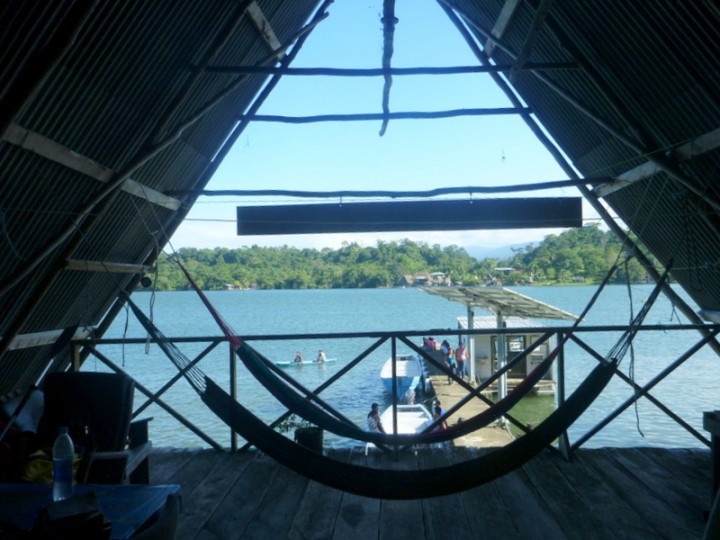Fun was the point of expedition rafter Lacey Anderson’s trip to Guatemala, but enlightenment was the result. Find out how a scary hostage situation and other tense encounters led Lacey and members of her team to organize aid for indigenous Guatemalans.
When the angry mob in the highlands of Guatemala got out ropes and gasoline, and then made neck-slicing gestures with their hands, I didn’t have to speak Mayan to understand what they had in mind for us. I came to the shocking realization that this could truly be my last day alive (see the two C&K articles Access Denied, Rio Copon Update). My thirst for adventure and expedition-style boating had taken me deep into the Guatemalan highlands in an attempt to run the secretive Rio Copon, rumored to be the best multiday river trip in all of Central America. This is where our group of would-be river-liberating boaters and documentary filmmakers was mistaken for corporate meddlers associated with dams and mining, and, as a result, held hostage by four separate villages, each of which threatened live burning as punishment. Heroic negotiations and a selfless offer of one person’s freedom in exchange for the lives of our group (by one of our Guatemalan companions) eventually won our release. Only then did I realize it wasn’t my last day, after all.

That hostage experience was a life-altering event for me—one that is difficult to describe, especially the depth of emotion I felt. Once I was safely back home, I began intense research into Guatemalan history, and discovered some gruesome facts. Modern destruction of the traditional Mayan lifestyle began with a civil war spanning from 1960– 1996, resulting in over 200,000 deaths. The majority killed were of Mayan descent. Many of the remaining survivors were forced into hiding. They left their traditional homelands and resettled in other regions of Guatemala, mainly in the highlands or in the dense jungles. No longer were they able to reside in the fertile valleys of their ancestral homeland. The vast majority of human rights violations perpetrated during the conflict were carried out by state forces and military groups. U.S. involvement in Guatemala, including training of officers in counterinsurgency techniques and assisting the national intelligence apparatus, has also been singled out as having contributed to human rights violations.

The persecution of the Mayans continues today through the influence of large corporations (many U.S. and Canadian) and corrupt politicians. There is a huge push for mining precious metals and constructing hydroelectric dams. It just so happens that many of these resources are in the same regions that exploratory river runners want to enjoy. The Mayans once again find themselves defending their homelands, only this time they are more united and hardened by a violent past. The isolated Mayan populations are appropriately suspicious of strangers and willing to fight to the death to protect their culture and land. It’s true that the Mayans of the Guatemalan highlands almost took our lives, but now I understand much more about why this clash of cultures occurred. I was profoundly shaken by the hostage situation, but, looking back, I can see that the end result was positive. Members of our multi-national team of boaters have since started two NGOs, RIOS Guatemala-USA and Associacion RIOS Guatemala, which share the goal of protecting Guatemalan rivers while providing opportunities for local people whose well-being depends on them. (RIOS Guatemala-USA is based in the United States, while Associacion RIOS Guatemala is directed by the Guatemalan contingent of boaters from our team.)

November 2013, a year after our hostage situation, I returned to Guatemala to see how I could help with the formation of RIOS Guatemala-USA. There is much work to be done in establishing this type of organization. We began with stops at the village of Seacacar and the Sauce, places the RIOS Guatemala-USA founders selected to begin doing research and working with the indigenous population.

RIOS Guatemala-USA was considering sponsoring students from the small village of Seacacar to attend the three-year vocational boarding school at Ak´Tenamit. The meeting in Seacacar between representatives of RIOS Guatemala-USA, a representative of Ak’ Tenamit, and citizens of Seacacar was very productive. Seacacar citizens expressed that they wanted our help. They realized that their village is sitting on valuable property and they were not sure how to best utilize their resources. They suggested that as a team we could come up with alternatives to slash-and-burn agriculture, support their children’s higher education goals, and unite in the protection of the land from corporate interests.

As of right now, the children of the village get very little education. A lucky few make it as far as 6th grade, but the rest receive little or no schooling. So, RIOS Guatemala has set up a scholarship fund to help students attend the Mayan-run boarding school of Ak´Tenamit.

After the meeting at Seacacar, our group dispersed, but I decided to stay in Guatemala a bit longer. My plan was to volunteer as an English teacher with Ak´Tenamit. If you know me, this makes sense, because I worked for over ten years as a teacher. I taught science and math with a specialized license for teaching non-Engish speaking students. I thought it might be a rewarding experience to teach English at Ak´Tenamit. I also wanted to meet the students that RIOS Guatemala was sponsoring.

I volunteered for two months, living in the volunteer-housing galera (boathouse) and being fed the same food that the students ate (beans and corn tortillas for breakfast, lunch, and dinner). Teaching at Ak’ Tenamit turned out to be an amazing and humbling experience. I am reminded of the Aristotle quote, “The more you know, the more you know you don´t know.” It was a positive experience, but I discovered I had a lot more to learn about indigenous Guatemalan culture.

RIOS Guatemala’s mission continues to evolve as we learn more about the needs of the people. Just recently RIO Guatemala–USA announced this shift in strategy:
Instead of providing scholarships and sending students to the three-year vocational boarding school at Ak’ Tenamit, we will fund Ak’ Tenamit graduates to teach in riverside communities. A student count in Seacacar is now being conducted, and classes will begin shortly. This shift allows us to reach more students and builds trust in the community. Our teacher will also work with the local Mayan people to determine how tourism and other micro-enterprise efforts can provide a sustainable income source to expand educational and other opportunities.

Over the last few years these experiences have opened my eyes to how fortunate I am to have been born a U.S. citizen as opposed to being born in the third world. Life can be so hard for people living in developing countries, particularly for the indigenous populations. I am honored to have been put through these trying and often stressful experiences, as it has opened my eyes and given me a deeper appreciation for life and living in the moment. Some ignorance and intolerance, on my part, has been peeled away. This interesting journey began when I casually went into the Guatemalan highlands with the intent of being part of a conservation film about the Rio Copon, and ended up being part of an international hostage incident. I am sincere when I say that fun was the point, but enlightenment was the result.
Go to www.riosguatemala.com for information on how you can help make the RIOS Guatemala vision a reality.